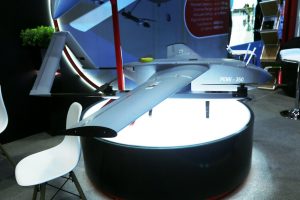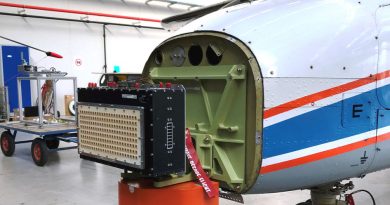
UMEX 2024 – The Bulgarian company Hades expects a large order for the NEM-600 jet drone
The Bulgarian company Hades Defence Systems expects to receive a large launch order in the middle of the year for its new unmanned aerial vehicle (UAV) NEM-600, designed to engage a wide range of armoured targets.
As Georgio Markov, the Business Development Department regional manager at Hades, told EDR On-Line at UMEX-2024, all testing of the NEM-600 (Nemesis) has now been completed and mass production is planned to begin in June for the benefit of the starting operator, whose name has not been disclosed. Also, according to Markov, the developer is negotiating the supply of its new UAV with a number of other potential customers.
The NEM-600 is a low wing jet aircraft, the reactor air intakes being visible on both sides of the fuselage. The airframe is fitted with a horizontal tailplane and a vertical rudder. The jet engine is installed in the tail section of the vehicle.
The UAV can be launched from a catapult and is used as a kamikaze drone. The NEM-600 can also take off and land on runways using a three-wheel retractable landing gear.
The Nemesis kamikaze drone is equipped with a cumulative warhead in the nose and is capable of penetrating up to 800 mm of rolled homogeneous armour. According to the developer, it can be used in all scenarios, including urban areas, as well as in any weather conditions. The hit accuracy is under 1.5 metres, which ensures minimal collateral damages when striking a point target.
The NEM-600 has a wingspan of 3.5 meters, a version with a 2.5 metres wingspan being also available. With a maximum speed of 450 km/h, a maximum flight altitude of 6,000 metres, a communication range of 50 km and a flight range of 70 km, the Nemesis is suitable for short range tactical operations and the destruction of strategic targets.
Capabilities such as near-target loitering, pre-programmed flight paths, autopilot and controlled flight make the NEM-600 a versatile and ease deployable system.
The drone is capable of high-speed flight at an extremely low altitude while skirting the terrain, which prevents it from being detected by enemy radars. The compact airframe made entirely of radioabsorbing material, and the use of insulation to all internal metal and electronic components, contribute to reduce its radar cross signature.

At UMEX-2024, Hades Defence Systems also presented its PENV series of vertical takeoff and landing (VTOL) UAVs, designed to perform short- and medium-range reconnaissance missions.
According to Markov, PENV-250/350 drones can be used for surveillance on land and at sea, for example with Coast Guard units. These UAVs have an aircraft design with a high-mounted, very low-sweep wing, which guarantees high-speed flight. At the same time, to ensure the VTOL mode, two two-blade propellers are placed on two side beams installed under the wings. The side beams are connected to the tail unit in an inverted V shape.
The PENV series UAVs are powered by an electric motor, providing an endurance of 2-3 hours. At the same time, the UAV can be adapted to use a hybrid internal combustion engine, which increases endurance to 6-8 hours. The flight range of the PENV-250 is 320 km (PENV-450 – 420 km), flight altitude is 5,000 metres (6,000 metres), payload weight being 3 kg (5 kg).
The PENV series UAVs are equipped with a water- and dust-proof optoelectronic/infrared camera, allowing operation both day and night. According to Markov, Hades is supplying its PENV series drones to a number of operators around the world.
He also emphasized that all main components of these UAVs are produced in Bulgaria.
Photos courtesy N. Novichkov



